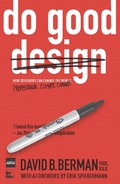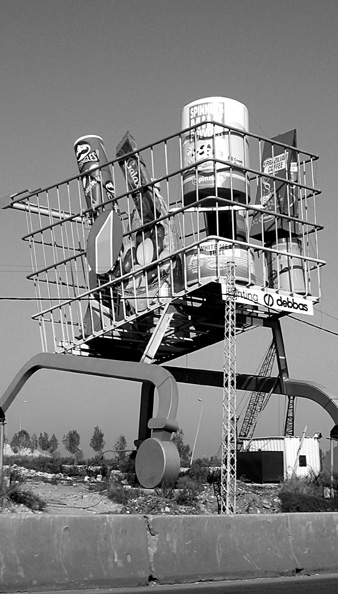
Monstrous shopping cart pushing popular brands for Spinneys supermarket, highway to Beirut
OUR SOCIETY HAS A LEGAL CODE that is based on words. We’re trained to recognize word-based lies. The most subtle of inaccurate innuendo in words uttered by a politician can resonate for many news cycles or even end a career.
But because of our relatively low visual literacy, it’s not as obvious to us when images have been cleverly strung together to create a visual lie. When a sentence is made up of pictures, and the sentence is not truthful, we’re less likely to call a foul. Lies in words are controlled with libel and fraud laws, while subtle visual lies are often not – and so many creative liars can continue to operate with impunity.
A well-crafted visual lie can be far more powerful than a lie built solely of words, because images provoke subconscious, visceral reactions. The imagery can be so subtle that people often don’t realize they are being manipulated.

Red cross brand on pharmacy in Macau
Humans excel at real-time pattern recognition: your brain constantly edits visual input, even before you are conscious of it. Your built-in Steadicam is constantly editing what comes in, without you being aware of the process. To demonstrate this to yourself, put a video camera on your shoulder, start recording, walk twenty steps, then compare the smooth image you perceived to the jerky, bouncy image that actually met your eyes. This is why reading when the bus is on a rough road can be nauseating: the mental Steadicam gets overloaded and demands to be shut off. We are completely unaware of the extensive adjustment to raw sensory data going on in our brains.
The annual productivity loss due to people having to process spam e-mails is measured in billions of dollars. And we all actively hate it because we are conscious of it: it is not only an annoyance to have to wade through, it also interrupts our focus on important things. However, what do you suppose is the annual loss due to the spamming of our unconscious with advertising, where the over-load presents itself in the form of low-level stress, unexplained shopping, and skewed behavior, rather than nausea?
Imagine civilization just a few hundred years ago: you could go for days without an advertisement interrupting your thoughts. The only time I go more than a night without seeing ads is when I’m in a hospital bed or on a canoe trip.
To survive in the forest, we also evolved the skill of processing an overwhelming amount of information, gleaning what matters based on what we are already know.
Try this: read the following sentence out loud only once, and as you go, count how many times you see the letter F. Ready? Go.
FEDEX FORMS ARE THE RESULT OF YEARS OF CUSTOMER FEEDBACK COMBINED WITH THE EXPERIENCE OF MANY DESIGNERS.
How many Fs did you count?
If you noticed all six, the chances are that English isn’t your mother tongue. You were even more likely to find them all if you did not grow up with the Roman alphabet. If you show this to a child, they would probably score higher than you did.
If we can miss what is really going in such a straightforward situation as reading a sentence, imagine how much else we miss every hour because of our cultural and experiential filters. Now imagine how easily someone could manipulate us, taking advantage of all the gaps between how well we think we process information and how well we actually do.
If you’re taking in a stream of words, you can stop in the middle and decide, “I don’t want to read anymore.” However, consider what happens when you are confronted with a barrage of images.
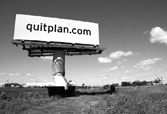
Help or hindrance? Health Canada would likely say this reminds people to smoke.
For instance, you see many peripheral visual messages while traveling down a highway or surfing the Internet. In both cases, out-of-context messages – whether billboards or banner ads – are intentionally thrown in your path in hopes of catching you unawares. Even more subtle are product placements in movies, or the sugarcoated Web-based “adver-games” for children that actually sell breakfast cereal or toys. It’s simply not possible to prefilter all the arriving visual information. Even if you choose to focus on one of many simultaneous incoming streams, by the time you shut your eyes the image is already burned into your memory. And so much of the barrage sticks in your subconscious, unedited, with great power to influence your emotions and decisions.
In the forest, or even on a highway that includes road markings and warning signs, these mechanisms are all helpful for survival, because all that extra input is real and useful. However, consider that 94 percent of the Web sites most popular with Canadian children and teens include marketing materials.[119] I believe that as our society becomes increasingly visually literate, we will reject as abusive this visual overloading designed to deceptively manipulate consumer choice. Until then, as long as designers continue to engage in this systematic deceit, we drag down both our profession and our spirits.
Some people tell me I should lighten up: that adults have the power and responsibility to decide if they want to respond to ads or not. And frankly, if we are stupid enough to believe that there are two scoops of raisins in every box of Kellogg’s Raisin Bran, even though Raisin Bran comes in many sizes of box, it is tempting to declare that we deserve what we get. Indeed, if we had nothing else to think about, if we were all 100 percent healthy, undistracted, and stress-free, and if these messages were presented in a straightforward way one by one, maybe it would be true that we would be poised to take on all the ads we encounter and consider them one by one. But, like so much spam to delete, they wear us down, and intentionally so.
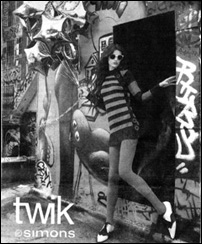
When Peter Simons returned to Montréal from a trip to Europe, he had a problem on his hands. The new fall 2008 junior women’s fashion catalogue for his La Maison Simons clothing store was in his in-basket, and so were 300 messages from customers upset about the too-thin models being used to appeal to this audience most at risk for anorexia. The conversation that hit him hardest was from a woman whose bulimic sister had killed herself. When I spoke to Peter the following day, he explained that it took him around 15 minutes to decide to recall the catalogue. Rather than waste more trees, he decided that there would simply be no catalogue that season.
That’s a real-life story, with people speaking up to make a difference, and an ethical corporate owner making economically tough and humbling decisions. What will they do differently in the future? “We lost sight of our corporate values, and did harm unnecessarily. We’ve set a policy on body-mass index for future models. We let down our customers: it won’t happen again.” We need more like Peter.
Imagine that you’re a design professional, wrestling with an ethical challenge that has arisen in your work. A client comes to you and says, “Our warehouse is full of widgets we need to sell off and we’d like you to lie in such-and-such a way to get rid of them – and quick.” There is bound to be a better way than deception. A creative, ethical solution almost always exists that provides a desirable outcome for both the direct and indirect parties involved.
The direct parties are the direct buyers and sellers (the client, the design firm, and the client’s client). The indirect parties to the transaction (remember those externalities?) are the profession, the society, and the environment.
Good design is a strategic, sustainable, ethical response to a business problem. You could come back to that widget manufacturer and say, “Perhaps we could sell a lot of product by telling these white [or not-so-white] lies, but, in the long run, we’re going to make you more profit if we speak the truth when selling your product. Plus, we can design a solution that will contribute to your long-term sustainability, as well as that of our agency, our society, and our global environment.” If we can’t find an appropriate way to package and promote to the intended audience, then perhaps we’re seeking the wrong audience. And if we can’t find an appropriate audience, then the product begs to be redesigned.
In politics, it may be easier to win an election by “swift-boating” the opponent than making credible proposals on how your candidate would improve society if elected, but that does not make it right. Mudslinging robs voters and entire democratic communities of the ability to make informed choices. Similarly, focusing on the frivolous properties of a product distracts consumers from the pertinent information that would put great products in the hands of those that need them.
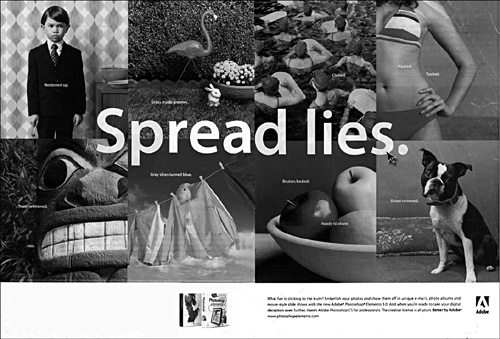
Adobe pokes fun at themselves: Photoshop has become a mainstream verb
Yes, you will have to think a little harder. It’s no coincidence that being forced to think more creatively results in increased innovation.
Yes, it means more time spent on strategy. No problem: I’ve yet to see a single design project that suffered from too much time spent on strategy. Such time always more than pays for itself in saved time later in the process, and of course it yields better results. If the client thinks that the strategy is set, and that you were simply hired to execute, then push back and engage them in the strategic discussion. Show what you have to offer.
When the dust clears, you’ll be more useful to the client than if you had just blindly said, “Sure, we’re happy to play the role you’ve defined for us in your game.” Instead of saying no, you can provide a better version of yes. And you’ll find that if you provide your services in that way to clients, over time the fly-by-night clients will disappear, and the clients you really want will stick with you.
If your employer assigns you work that you are uncomfortable with ethically, you don’t have to quit your job; you can respectfully request to be put on another project. Whether uncomfortable with the candidate, the message, or the product, designers must have the option and the courage to say no to assignments that are not aligned with their ethical principles, whether working for themselves or in a design studio. (And subscribing to a code of ethics makes saying no very easy: “I’d love to help you, but it would contravene my professional code of ethics, and of course I can’t risk losing my certification: I’m sure you understand.”)
In my design firms, designers have always had the option to decline to work on a job with sufficient reason. For instance, if we take on a political project, a designer whose politics contradict the goals of the project can refuse to work on it. If you have designers working for you, make this choice part of your human resources policy... before it comes up.
Ultimately, you’ll have the clients (or the boss) you deserve.
“Design creates culture. Culture shapes values. Values determine the future. Design is therefore responsible for the world our children will live in.” | ||
| --ROBERT L. PETERS | ||
